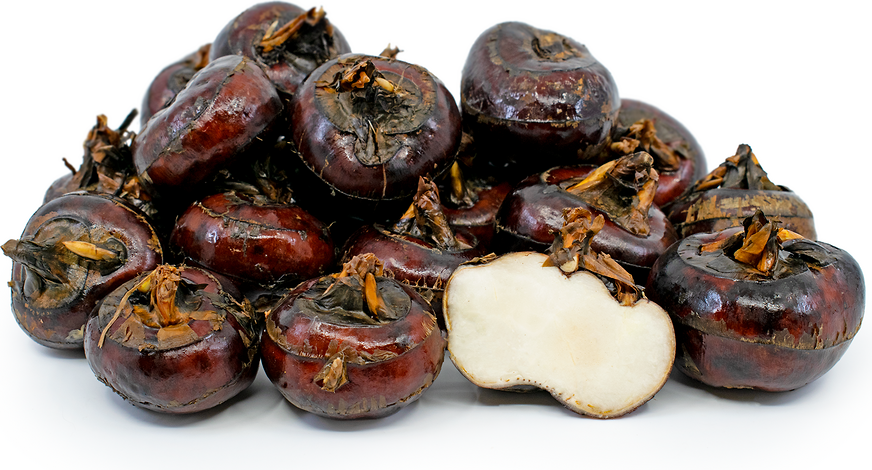


Waterchestnuts
Estimated Inventory, lb : 0
This item was last sold on : 02/04/25
Description/Taste
Waterchestnuts are the small, flattened, round corms or bulbs of a reed-like plant. They are 4 centimeters in diameter and 2 to 3 centimeters tall. They take 6 to 7 months to develop and are harvested when the leaf stalks begin to die, and the corms have developed a dark brown outer layer. Waterchestnuts have a bright white flesh with the texture of an Asian pear or apple. They offer a sweet, nutty flavor with a slight tartness.
Seasons/Availability
Waterchestnuts are available in fall and winter months through the spring.
Current Facts
Waterchestnuts are not nuts nor are they legumes as their name may suggest, they are aquatic tubers or roots, botanically classified as Eleocharis dulcis. They were named for where they are grown and for their resemblance to the classic winter nut. In the United States, Waterchestnuts are most often associated with Asian cuisine. In China, they are called Hon Matai and are featured in a wide range of dishes from savory stir-fry to sweet “sugar water” desserts.
Nutritional Value
Waterchestnuts are rich in potassium, manganese, copper, vitamin B6, dietary fiber and riboflavin. They contain phosphorus, calcium, iron and vitamin C. They are also a great source of antioxidants, especially ferulic acid, which helps them retain their crisp, crunchy texture when heated. Waterchestnuts contain a compound called punchin that has antibacterial properties.
Applications
Waterchestnuts can be eaten raw or cooked. The peel can be removed before or after cooking and a peeler or paring knife can be used to remove the skin. Slice, dice or leave them whole. Raw tubers can be eaten as is for a snack, shredded or grated for salads or slaws. Sweet applications call for adding Waterchestnuts to heated sugared liquids, like coconut milk, cow’s milk or water. These can then be made into desserts or beverages. Waterchestnuts maintain their crisp texture even when cooked. Wrap slices of Waterchestnuts in bacon and roast or toss in tapioca starch and fry. Add to stir-fry, omelets, soups or stews at the end of the cooking process. They can be chopped or shredded and added to meat for dim sum filling. Unpeeled Waterchestnuts can be stored in the refrigerator, in a sealed container with water, for up to 2 weeks. Peeled Waterchestnuts need to be stored in water and can be refrigerated for up to 3 days.
Ethnic/Cultural Info
Waterchestnuts are far more popular in Southeastern Asia and are typically eaten raw or sweetened for desserts. In China, skewers of stacked Waterchestnuts are sold by vendors at roadside stands. They are died red and sweetened for a dessert called 'rice in coconut milk’. In Indonesia, they are pureed to make a refreshing, cooling beverage or pounded and fried for chips known as ‘emping teki’. They have been used in traditional Chinese medicine for hundreds of years, and have been prescribed for diabetes, hypertension and other health issues.
Geography/History
Waterchestnuts are native to the tropical and sub-tropical regions of Southeastern Asia, and spread to Indonesia, Australia, India, Madagascar, and tropical western Africa. They are cultivated in flooded fields, and can be found growing in marshes, seasonal swamps, and along riverbanks. They are primarily cultivated in China, where larger corms, Hon Matai, are used for raw consumption, and smaller corms, Sui Matai, are used for starch production. Waterchestnuts can be found year-round in Asian markets, in cans or pickled in jars. Fresh Waterchestnuts are most likely spotted in their native region.
Recipe Ideas
Recipes that include Waterchestnuts. One

















